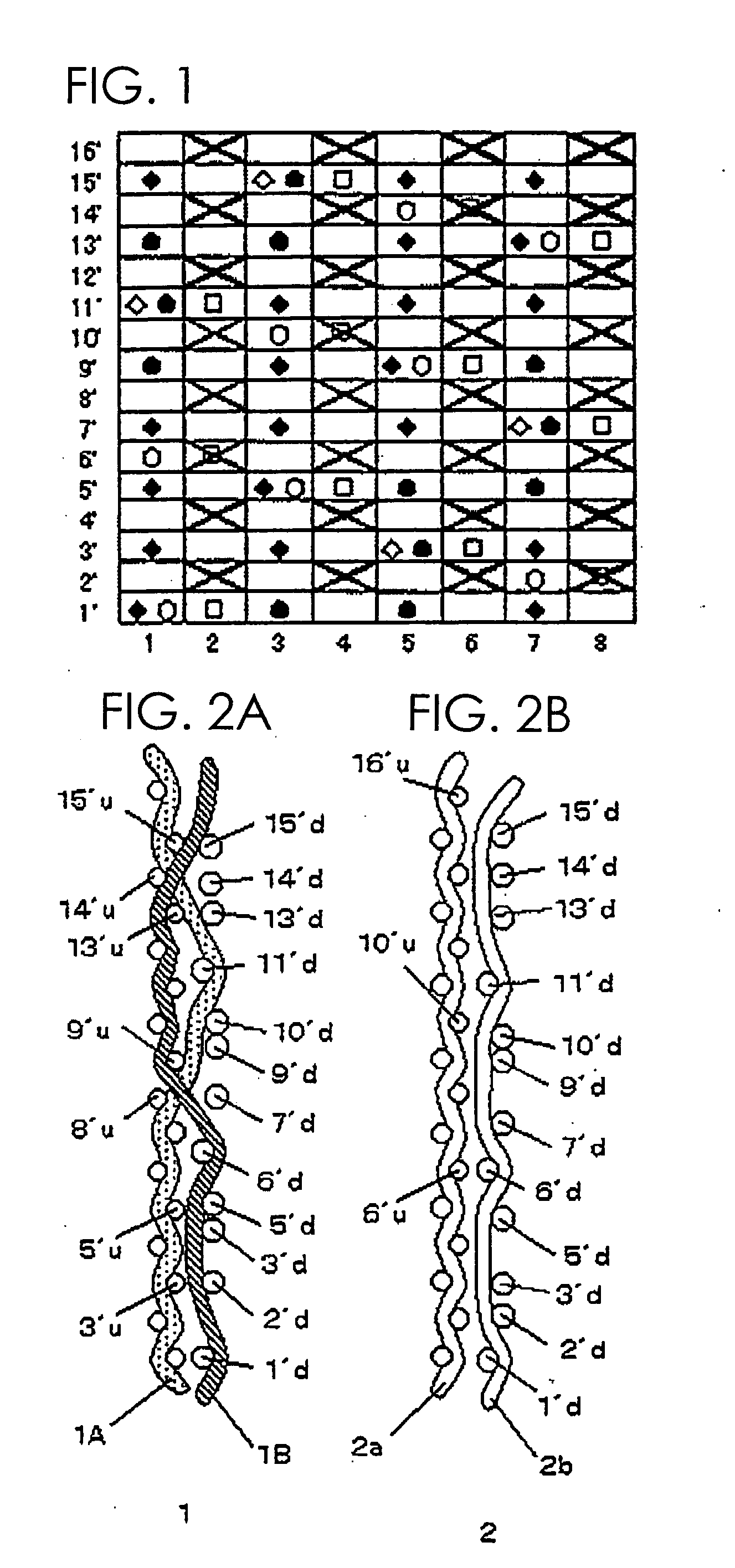Industrial two-layer fabric
a two-layer fabric and fabric technology, applied in the field of industrial two-layer fabric, can solve the problems of warp protruding from the lower surface side surface, not suited to applications requiring wear resistance and rigidity, and easy to be worn away, so as to improve the surface property, run stability and water drainage, and improve the effect of wear resistan
- Summary
- Abstract
- Description
- Claims
- Application Information
AI Technical Summary
Benefits of technology
Problems solved by technology
Method used
Image
Examples
example 2
[0064] The fabric obtained in Example 2 is a 16-shaft two-layer fabric in which a pair of an upper surface side warp and a lower surface side warp and a pair of warp binding yarns are alternately arranged. A 1 / 3 twill weave design is adopted as the upper surface side surface design, while a 3 / 1 design is adopted as the lower surface side surface design. Upper surface side wefts and lower surface side wefts are arranged at 4:3, which is similar to Example 1.
[0065] In the design diagram of FIG. 4, indicated by numerals 1, 3, 5 and 7 are pairs of two warp binding yarns arranged vertically, and indicated by numerals 2, 4, 6 and 8 are pairs of an upper surface side warp and a lower surface side warp. Pairs of warps and pairs of warp binding yarns are arranged alternately.
[0066] The fabric of this example is different from that of Example 1 in the upper surface side surface design. Described specifically, an upper surface side warp and an upper surface side weft are interwoven to form a...
example 3
[0070] The fabric obtained in Example 3 is a 16-shaft two-layer fabric in which three pairs of an upper surface side warp and a lower surface side warp are arranged relative to a pair of warp binding yarns. This fabric is formed by alternately arranging, for warps of the upper surface side design, a 1 / 1 plain weave design and a 2 / 2 level weave design and, for the lower surface side design, a 1 / 3 design. Upper surface side wefts and lower surface side wefts are arranged at 4:3, similar to that of Example 1.
[0071] In the design diagram of FIG. 7, indicated by numerals 1 and 5 are pairs of two warp binding yarns arranged vertically, while indicated by numerals 2, 3, 4, 6, 7, and 8 are pairs of an upper surface side warp and a lower surface side warp. The pairs of warp binding yarns and the pairs of warps are arranged at a ratio of 1:3.
[0072] Upper surface side warps are woven alternately with upper surface side wefts and some of the upper surface side warps form a 1 / 1 plain weave des...
example 4
[0076] The fabric obtained in Example 4 is a 12-shaft two-layer fabric in which a pair of an upper surface side warp and a lower surface side warp and a pair of warp binding yarns are alternately arranged. This fabric is obtained by employing a 1 / 2 twill weave design for the upper surface side surface design and a 2 / 1 design for the lower surface side surface design. Upper surface side wefts and lower surface side wefts are arranged at 1:1.
[0077] In the design diagram of FIG. 10, indicated by numerals 1, 3, 5 are pairs of two vertically-arranged warp binding yarns, while indicated by numerals 2, 4 and 6 are pairs of an upper surface side warp and a lower surface side warp. Pairs of warp binding yarns and pairs of warps are arranged at 1:1.
[0078] Upper surface side warps are woven with upper surface side wefts to form a 1 / 2 twill weave design on the upper surface side surface. Warp binding yarns forming a pair alternately appear on the upper surface side surface, function as one wa...
PUM
 Login to View More
Login to View More Abstract
Description
Claims
Application Information
 Login to View More
Login to View More - R&D
- Intellectual Property
- Life Sciences
- Materials
- Tech Scout
- Unparalleled Data Quality
- Higher Quality Content
- 60% Fewer Hallucinations
Browse by: Latest US Patents, China's latest patents, Technical Efficacy Thesaurus, Application Domain, Technology Topic, Popular Technical Reports.
© 2025 PatSnap. All rights reserved.Legal|Privacy policy|Modern Slavery Act Transparency Statement|Sitemap|About US| Contact US: help@patsnap.com



